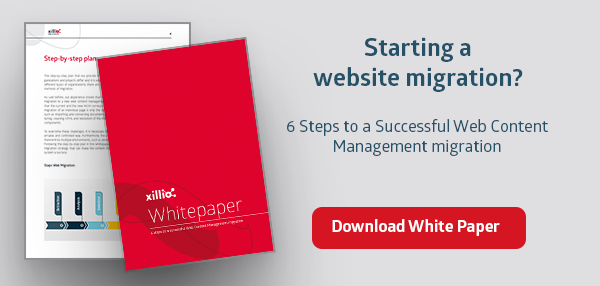Recommendations for Your Migration to Adobe Experience Manager
by Marijn van der Zaag, on Oct 29, 2018 11:01:00 AM
Adobe Experience Manager (AEM, and formerly known as Adobe CQ5) seems to be getting more popular and we see a major increase in requests for content migrations from legacy web applications or CMSes, like TeamSite, Sitecore, Tridion and Drupal, to Adobe Experience Manager. A web content management system migration to Adobe Experience Manager is a large undertaking for an organization and can cause a lot of frustration. Here are a few recommendations for your move to AEM:
1. Analyze content structure
First and most essential step, is to understand the site structure and metadata usage of the source system. To do so, the items (pages, components) from the source can be downloaded and saved as XML files, and their metadata saved to a database. At Xillio, we save this information to in the unified content model. When migrating from multiple sites into one Adobe Experience Manager instance, this can be quite a project. The analysis of the downloaded content can be used to map the content with related elements in AEM and set up the transformation rules. Clean up
Clean up
As with any other website, it is likely that your website content contains outdated information, old landing pages, images and files. Maybe the quality of your content does not suit your new platform and new design anymore. Before moving all of this to your new website, you want to clean up and adjust content. Try to determine upfront if and how content updates will be required, so you know how much time and effort you need from your editors.
Update metadata
Metadata is essential when it comes to search and accessing content on a website. Still content editors forget to fill out important metadata, like the meta description, or duplicate metadata occurs when pages are cloned. In case of a migration to a new CMS, adding missing metadata is a key task to enhance the quality of website. This can be done automatically.
Use Sling APIs
AEM is built on JCR (java content repository) and Apache Sling technology for its REST services. It is possible to programmatically retrieve AEM resources from this JCR using Sling APIs. And, this can also be used to import components to Adobe Experience Manager and meanwhile building up the entire structure of the new site. Special care needs to be taken as AEM does not perform content validation and will accept any well-formed payload that is offered without checking if it actually makes sense.
(Source: https://helpx.adobe.com/experience-manager/using/using-sling-apis.html)
Because content on the source system could have been on other locations than it is in the new AEM instance, there is a need to resolve all the links after a migration. For instance, all the images were grouped inside one folder on the source system and now they are in Adobe Experience Manager. Then the URLs for the images need to be replaced, otherwise the images will not show on the target system. The same counts for pages, templates, binaries, etc. Adobe Experience Manager is an extremely flexible solution, but do not underestimate or overlook a content migration to Adobe Experience Manager. These recommendations can help you preparing your migration to AEM. If you are facing trouble, please inform an expert.
Adobe Experience Manager is an extremely flexible solution, but do not underestimate or overlook a content migration to Adobe Experience Manager. These recommendations can help you preparing your migration to AEM. If you are facing trouble, please inform an expert.
------------------------------------------------------------------------------------------





%20(300%20x%2060%20px)%20(3).png?width=635&height=127&name=ISO%20email%20signature%20(390%20x%2060%20px)%20(300%20x%2060%20px)%20(3).png)